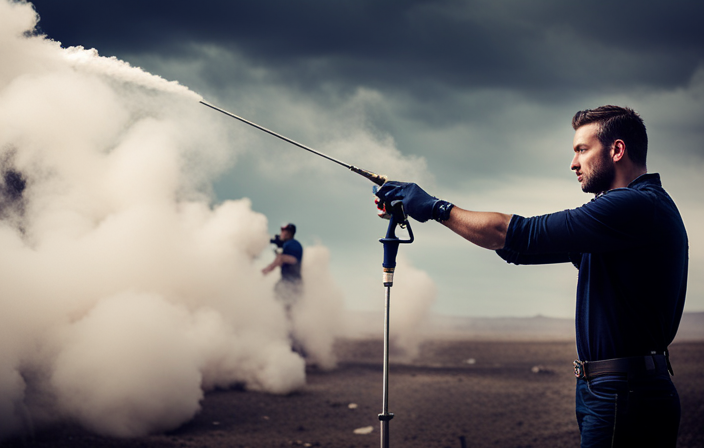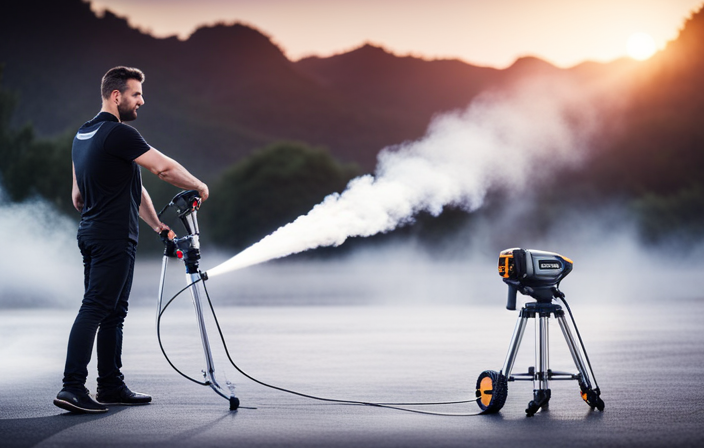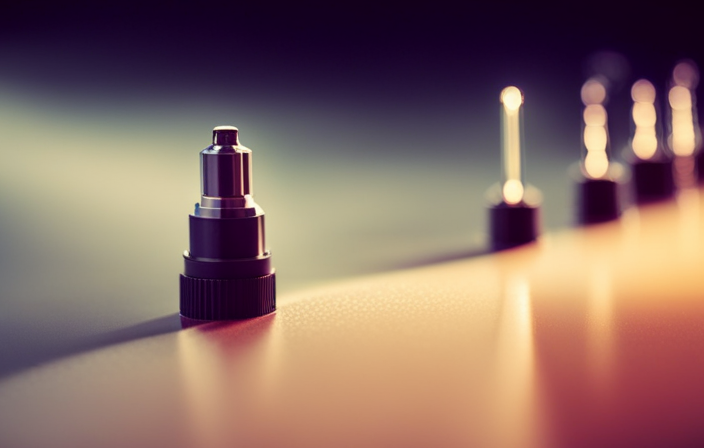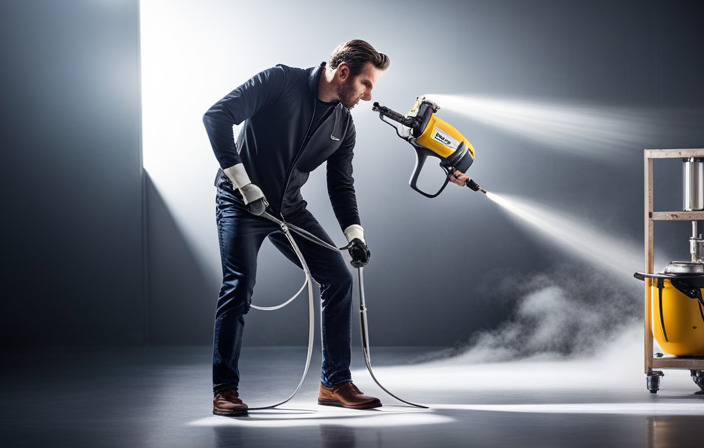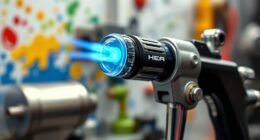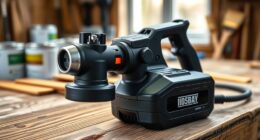Do you ever wish you could extend your reach while painting? Well, I have good news for you! With the right techniques and tools, you can make that wish a reality. In this article, I’ll show you how to enhance the capabilities of an airless paint sprayer so you can easily tackle those hard-to-reach spots.
Now, I know what you’re thinking – ‘Is this really possible?’ Trust me, it absolutely is. By using a combination of the right extension wand, proper preparation, and a few handy tips, you’ll be able to paint high ceilings, tall walls, and even tricky corners without breaking a sweat.
So, get ready to unlock the full potential of your airless paint sprayer. Follow these step-by-step instructions, and soon you’ll be enjoying the benefits of extended reach and saving precious time during your painting projects.
Let’s dive in and make your painting dreams come true!
Key Takeaways
- Choosing the right extension wand based on length, material, and compatibility with the airless paint sprayer.
- Ensuring proper pressure adjustment to improve paint flow, control speed and amount of paint, and choose the right extension wand.
- Starting painting from the highest point for safety, maintaining consistent distance, and achieving a professional finish.
- Maintaining a consistent distance from the surface to prevent clogs, adjust spray pattern, and achieve an even coat.
Choose the Right Extension Wand
To choose the right extension wand, consider the following factors:
-
Length: Select an extension wand that is the appropriate length for the task at hand. A wand that is too long can be difficult to maneuver and may cause strain on your arm. On the other hand, a wand that is too short may not allow you to reach high or distant areas effectively. Take into account the height of the surfaces you will be painting and choose a wand that provides ample reach without being too cumbersome.
-
Material: Extension wands are typically made of different materials, such as aluminum, fiberglass, or stainless steel. Each material has its own advantages and disadvantages. Aluminum wands are lightweight and easy to handle, but they may not be as durable as fiberglass or stainless steel wands. Fiberglass wands are sturdy and resistant to corrosion, making them suitable for outdoor use. Stainless steel wands are extremely durable and can withstand high pressure, but they may be heavier than other options. Consider the specific requirements of your project and choose a wand material that best suits your needs.
-
Compatibility: Ensure that the extension wand you choose is compatible with your airless paint sprayer. Check the manufacturer’s recommendations or consult the user manual to determine the compatible wand types and sizes for your sprayer model. Using an incompatible wand can affect the performance of your sprayer and may lead to issues such as clogging or uneven spray patterns.
-
Additional features: Some extension wands come with additional features that can enhance your painting experience. For example, certain wands have adjustable spray tips or swivel heads that allow you to easily change the spray pattern or reach difficult angles. Consider these features and determine if they would be beneficial for your specific painting needs.
Choosing the right extension wand is essential for achieving optimal results with your airless paint sprayer. By considering factors such as length, material, compatibility, and additional features, you can ensure that you have the appropriate wand for the job at hand.
Prepare Your Paint and Equipment
Before getting started, make sure you’ve got all your materials and gear ready to go. To prepare your paint and equipment for extending your airless paint sprayer, there are a few key steps to follow. Firstly, gather the necessary tools needed for the job, including a paint strainer, a stir stick, and a clean bucket. Secondly, choose the best paint brand for your project, ensuring it is compatible with your sprayer. High-quality paint brands like Sherwin-Williams or Behr are recommended for optimal results. Lastly, strain the paint into the clean bucket using a paint strainer to remove any impurities that could clog the sprayer. Now that your paint and equipment are prepared, you can move on to the next step of securely attaching the extension wand.
Securely Attach the Extension Wand
Once you have properly prepared your paint and equipment, it’s essential to securely attach the extension wand to your airless paint sprayer.
To ensure a proper technique for holding the extension wand, grip it firmly with your dominant hand. Keep your arm relaxed and extended for better control and stability during the painting process.
Avoid common mistakes when using an extension wand. One mistake is applying excessive force, which can lead to uneven paint application or damage to the sprayer. Another mistake is not maintaining a consistent distance between the wand and the surface being painted, resulting in an inconsistent finish.
Proper pressure adjustment is crucial to achieve optimal paint flow and coverage. Transitioning into the subsequent section about adjusting the pressure settings, it’s important to note the significance of proper pressure adjustment.
Adjust the Pressure Settings
To ensure a smooth and efficient painting process, it’s important to adjust the pressure settings on your equipment. Studies have shown that using the correct pressure can improve paint flow by up to 20%. When adjusting the pressure, it’s crucial to choose the right extension wand for the job. The extension wand allows you to reach high or hard-to-reach areas with ease. To help you understand the importance of pressure settings, refer to the table below:
| Pressure Setting | Paint Flow Rate |
|---|---|
| Low | Slow |
| Medium | Moderate |
| High | Fast |
| Very High | Very Fast |
| Maximum | Maximum |
By adjusting the pressure settings, you can control the speed and amount of paint being sprayed. This ensures an even coat and prevents drips or uneven coverage. Now that you know how to adjust the pressure, let’s move on to the next step of starting painting from the highest point.
Start Painting from the Highest Point
To create a breathtaking masterpiece that will leave your audience in awe, begin at the highest point. When using an airless paint sprayer, it’s crucial to start painting from the highest point of your project. This ensures that gravity helps distribute the paint evenly and prevents any drips or runs.
Before you begin, make sure you have taken all necessary ladder safety precautions. Secure the ladder and wear appropriate safety gear to avoid any accidents.
Additionally, remember to maintain a consistent distance from the surface to ensure an even coat of paint. This will help achieve a professional finish and prevent any inconsistencies in color or texture.
By starting at the highest point and following these paint sprayer maintenance tips, you will effortlessly create a flawless finish that is sure to impress.
Maintain a Consistent Distance from the Surface
To maintain a consistent distance from the surface, follow these steps:
- Keep a steady distance from the surface to ensure a flawless and professional finish.
- Adjust the spray pattern to achieve consistent results.
- Follow the manufacturer’s instructions for the paint to thinner ratio to maintain proper paint consistency.
- Prevent clogs and ensure a smooth flow of paint by following the recommended ratio.
- Adjust the spray pattern by turning the nozzle or adjusting the pressure settings.
- The spray pattern determines the width and direction of the paint spray.
- Achieve an even coat of paint by maintaining a consistent distance from the surface and adjusting the spray pattern.
- Enhance the appearance of any surface by using smooth, overlapping strokes.
In the next section, we will discuss the technique of using smooth, overlapping strokes for a professional finish.
Use Smooth, Overlapping Strokes
As I glide the sprayer across the surface, my strokes merge together like brushstrokes on a canvas, creating a seamless and captivating finish.
To achieve this effect, it is crucial to use smooth, overlapping strokes when using an airless paint sprayer. By employing the overlapping technique, I ensure that every inch of the surface is evenly coated, leaving no patches or streaks.
Maintaining a consistent distance from the surface is also essential. This distance, typically around 12 inches, guarantees an even application of paint and prevents overspray.
By combining the overlapping technique with the proper distance, I achieve a flawless and professional result.
Now, let’s move on to the next step and check for even coverage.
Check for Even Coverage
To ensure a flawless and professional result, it’s important to assess the uniformity of the paint application. Achieving an even application is crucial to avoid drips and inconsistencies in the final finish.
Start by visually inspecting the painted surface. Look for any areas that appear lighter or darker than the rest. Run your hand over the surface to feel for any rough or uneven spots.
If you notice any unevenness, it may be necessary to apply an additional coat of paint to achieve consistent coverage. Address any areas where the paint may have pooled or dripped, as these can detract from the overall appearance.
Once you have achieved an even application, you can move on to the next step of cleaning and maintaining your equipment.
Clean and Maintain Your Equipment
Ready to tackle the next step? Make sure you take good care of your equipment by cleaning and maintaining it properly.
Choosing the right cleaning solution is crucial to ensure the longevity and efficient performance of your airless paint sprayer. Look for a solution specifically designed for cleaning paint sprayers, as using the wrong solution can damage the internal components.
Follow the manufacturer’s instructions on how to clean the sprayer thoroughly after each use.
Proper storage techniques are also essential to keep your equipment in top shape. Store your sprayer in a clean, dry area, away from extreme temperatures and direct sunlight.
Regularly inspect the sprayer for any signs of wear or damage and make necessary repairs or replacements.
By properly cleaning and maintaining your equipment, you can enjoy your extended reach and time-saving benefits without any hassle.
Enjoy Your Extended Reach and Time-saving Benefits
Enjoy the convenience of reaching high and difficult-to-reach areas while saving time on your painting projects.
For example, imagine repainting the exterior of your two-story house. With your newly cleaned and well-maintained equipment, effortlessly paint the second-floor windows and eaves without the need for ladders or scaffolding. This not only completes the job in record time but also reduces the risk of accidents and injuries.
The extended reach of your airless paint sprayer allows you to cover a larger area without constantly repositioning yourself or moving equipment. This increased productivity translates into time saved, as you can quickly move from one section to another with ease.
Additionally, the lightweight design of the sprayer reduces fatigue, allowing you to work for longer periods without feeling exhausted. With these benefits, your painting projects become more efficient and enjoyable.
Frequently Asked Questions
Can I use any type of extension wand with my airless paint sprayer?
Yes, you can use various types of extension wands with your airless paint sprayer. Using an extension wand provides several benefits such as reaching high or difficult-to-access areas, reducing strain on your body, and improving overall efficiency during paint sprayer maintenance.
How do I know if my paint is compatible with an airless paint sprayer?
Yes, it is possible to use an airless paint sprayer with water based paints. The benefits of using an airless paint sprayer for large painting projects include faster application, even coverage, and the ability to handle thicker coatings.
What is the recommended pressure setting for extending the reach of the sprayer?
The recommended pressure setting for extending the reach of the sprayer is typically around 1500-2000 PSI. Using an extension wand allows for better access to high and hard-to-reach areas, increasing efficiency and reducing the need for ladders or scaffolding.
Is it necessary to clean the extension wand after each use?
Yes, it’s crucial to clean the extension wand after each use. This ensures proper functioning and prevents paint buildup. Remember to wear protective gear, and when using an airless paint sprayer indoors, ensure proper ventilation for safety.
Can I use the extended reach feature of the sprayer for all types of surfaces and angles?
Using the extended reach feature for hard-to-reach areas is highly beneficial when using an extension wand with an airless paint sprayer. It allows for painting surfaces and angles that would otherwise be difficult to reach, resulting in a more efficient and professional-looking paint job.
Conclusion
In conclusion, extending an airless paint sprayer can greatly increase your reach and save you valuable time. By following the steps outlined in this article, you can ensure a smooth and efficient painting process.
For example, let’s say you are painting the exterior of a two-story house. By using an extension wand, you can easily reach the upper levels without the need for ladders or scaffolding. This not only saves time, but also reduces the risk of accidents and injuries.
So go ahead, extend your paint sprayer and enjoy the benefits of increased reach and productivity.
